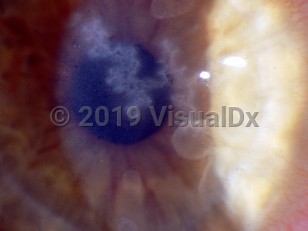Emergency: requires immediate attention
Herpes simplex virus keratitis - External and Internal Eye
Alerts and Notices
Important News & Links
Synopsis

Herpes simplex virus (HSV) infection is one of the most common viral infections of the eye and periocular skin. The majority of people over the age of 60 will be seropositive for HSV-1. Infection tends to follow the distribution of the trigeminal nerve. Most ocular infections are due to HSV-1; HSV-2 can also cause infection but is much less prevalent.
Primary infection can include a range of manifestations, such as a blistering rash on the face that may or may not involve the eye and orbit or an upper respiratory tract infection that goes undiagnosed as HSV. In a small percentage of the population, HSV can return to involve the eye at any time after the primary infection. This will typically involve only one eye; it is very rare for HSV to involve both eyes at the same time.
Recurrent bouts of HSV keratitis can cause permanent corneal scarring and loss of vision. Many people believe that stress, sunlight, and illness induce recurrence, but this has not been corroborated in scientific literature.
Patients will often present with foreign body sensation, light sensitivity, poor vision, and a red eye. Many times, patients will report a history of similar episodes in the past.
Immunocompromised Patient Considerations:
Human immunodeficiency virus (HIV) patients have a higher rate of incidence and recurrence of HSV ocular disease (mainly reported for keratitis) and may take longer to heal, but the ocular manifestations of the disease are not notably more severe.
Related topics: HSV blepharitis, HSV conjunctivitis
Primary infection can include a range of manifestations, such as a blistering rash on the face that may or may not involve the eye and orbit or an upper respiratory tract infection that goes undiagnosed as HSV. In a small percentage of the population, HSV can return to involve the eye at any time after the primary infection. This will typically involve only one eye; it is very rare for HSV to involve both eyes at the same time.
Recurrent bouts of HSV keratitis can cause permanent corneal scarring and loss of vision. Many people believe that stress, sunlight, and illness induce recurrence, but this has not been corroborated in scientific literature.
Patients will often present with foreign body sensation, light sensitivity, poor vision, and a red eye. Many times, patients will report a history of similar episodes in the past.
Immunocompromised Patient Considerations:
Human immunodeficiency virus (HIV) patients have a higher rate of incidence and recurrence of HSV ocular disease (mainly reported for keratitis) and may take longer to heal, but the ocular manifestations of the disease are not notably more severe.
Related topics: HSV blepharitis, HSV conjunctivitis
Codes
ICD10CM:
B00.52 – Herpesviral keratitis
SNOMEDCT:
9389005 – Herpes simplex keratitis
B00.52 – Herpesviral keratitis
SNOMEDCT:
9389005 – Herpes simplex keratitis
Look For
Subscription Required
Diagnostic Pearls
Subscription Required
Differential Diagnosis & Pitfalls

To perform a comparison, select diagnoses from the classic differential
Subscription Required
Best Tests
Subscription Required
Management Pearls
Subscription Required
Therapy
Subscription Required
References
Subscription Required
Last Reviewed:07/29/2019
Last Updated:09/18/2019
Last Updated:09/18/2019

